
About UsThe Numismatic Bibliomania Society is a non-profit organization promoting numismatic literature. For more information please see our web site at coinbooks.org SubscriptionsThose wishing to become new E-Sylum subscribers (or wishing to Unsubscribe) can go to the following web page link MembershipThere is a membership application available on the web site Membership Application To join, print the application and return it with your check to the address printed on the application. Membership is only $15 to addresses in the U.S., $20 for First Class mail, and $25 elsewhere. For those without web access, write to: David M. Sundman, Secretary/TreasurerNumismatic Bibliomania
Society AsylumFor Asylum mailing address changes and other membership questions, contact David at this email address: dsundman@LittletonCoin.com SubmissionsTo submit items for publication in The E-Sylum, just Reply to this message, or write to the Editor at this address: whomren@coinlibrary.com
BUY THE BOOK BEFORE THE COINYou won't regret it! |
- WAYNE'S WORDS: THE E-SYLUM FEBRUARY 5, 2012
- REMINDER: SKLOW MAIL BID SALE NO. 15 CLOSES FEBRUARY 11
- NEW BOOK: OHIO SALES TAX REVENUES
- AMERICAN NUMISMATIC ASSOCIATION ORGANIZATIONAL STRUCTURE
- AN ENAMELED MEDAL OF W.H. ABBOTT
- MORE ON THE ROCHESTER NUMISMATIC ASSOCIATION
- MORE ON EDWIN F. BITTER'S INSCRIBED BROWNING
- CLIFFORD HEWITT - CHIEF ENGRAVER OR CHIEF ENGINEER?
- NOTES FROM E-SYLUM READERS: FEBRUARY 5, 2012
- COLONIAL JACK'S LONG WALK
- QUERY: MINT DIRECTOR RAYMOND T. BAKER MEDAL INFO SOUGHT
- A TALE OF TRAVELING COIN BUYERS
- MORE BANKNOTE MATH: GREEK INFLATION NOTES
- CAL WILSON'S NUMISMATIC REPOSITORY
- MORE THOUGHTS ON OLD-TIME COIN AUCTIONS
- ELDER'S RECOLLECTIONS ON AN OLD COLLECTOR
- MINNEAPOLIS PUBLIC SCHOOL CHALLENGE COINS
- JOHN PINCHES, LTD, MEDALISTS
- TELEVISION APPEAL BRINGS NEW LEADS IN STEWARTBY THEFT
- WHERE DID ANNIE OAKLEY'S BULLETS COME DOWN?
- THE BANK OF ENGLAND'S GOLD STOCKPILE
- CUTBACKS AT THE UTRECHT GELDMUSEUM
- THE MILHOUS COLLECTION OF BOCA RATON
- THE HIGHLAND MINT'S SUPER BOWL COIN TOSS COIN
- FEATURED WEB PAGE: THE HUNTERIAN COIN AND MEDAL COLLECTION
WAYNE'S WORDS: THE E-SYLUM FEBRUARY 5, 2012

New subscribers this week include Ray Bema and A. J. Lansen. Welcome aboard! We have 1,507 email subscribers, plus 171 followers on Facebook.
This week we open with a reminder of David Sklow's February 11 literature sale, an announcement of a new book relating to Ohio sales tax tokens, and a note about Larry Lee's Coin World commentary on the ANA organizational structure.
Other topics include W.H. Abbott, John Pinches, Edwin Bitter, Clifford Hewitt, John C. Lighthouse, Cal Wilson, Tom Elder, the Chapman brothers and Lyman Low.
To learn more about the new coin honoring Egypt's revolution, Colonial Jack's long walk, the Super Bowl toss coin, where Annie Oakley's bullets landed, and the traveling coin buyers who apparently don't know replicas when they see them, read on. Have a great week, everyone!
Wayne Homren
(whomren@gmail.com)
Numismatic Bibliomania Society
REMINDER: SKLOW MAIL BID SALE NO. 15 CLOSES FEBRUARY 11
MAIL BID SALE NO. 15 CLOSES FEBRUARY 11, 2012
 The clock is ticking, but there is still time to submit your bids on a wide variety of numismatic treasures in our auction sale.
The clock is ticking, but there is still time to submit your bids on a wide variety of numismatic treasures in our auction sale.
Many scarce deluxe editions from the library of Myron Xenos, the wonderful token & works from collector Russ Sears, rare medals and photographs of the American Numismatic Association, a few treasures from Bill Fivaz, a few wonders from Q. David Bowers including a set of the Niles Register and of course part I of a great west coast worldwide library that will continue in the next several sales.
Catalog is viewable on our web site and are available upon request at no charge Bidders may enter their bids via mail, telephone, email or fax. The sale closes Saturday February 11, 2012 at 8pm mountain time. However, any bids left on our answering machines or sent by email or fax on or before midnight on closing day will be accepted.
Sale number 16 June 2, 2012 will contain part II of the west coast library with several hundred 19th century catalogs, many works on Canadian numismatics, and some very special items from Myron Xenos!
DAVID SKLOW - FINE NUMISMATIC BOOKS
P.O. BOX 6321
COLORADO SPRINGS, CO 80934
TEL: (719) 302-5686
FAX: (719) 302-4933
finenumismaticbooks@aol.com
www.finenumismaticbooks.com
For more information on the sale, see: SKLOW MAIL BID SALE #15 CLOSES FEBRUARY 11, 2009 (www.coinbooks.org/esylum_v15n05a02.html)
NEW BOOK: OHIO SALES TAX REVENUES
Stamps, Punch Cards, Tokens, and Related Memorabilia
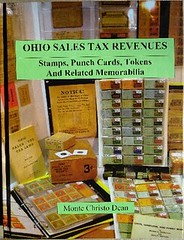 Limited Signed and Numbered First Printing of 100 copies.
Limited Signed and Numbered First Printing of 100 copies.
439 Pages, Case Hard Bound, 8.5 X 11,
777 Photographs, 146,000 words.
Book is black and white, with a CD offered showing all of those pictures in full color. Thousands of auction prices realized and price estimates, scarcity and rarity listings, with the most advanced Ohio Sales Tax Stamp Identification Index ever created with 268 types and 641 major varieties individually specified.
A short list of the topics covered in this book includes: Sales Tax Token Identification and Photo Index with details on Types and Varieties, Identification of Non-Conventional Merchant Punch Cards, Merchant Punch Cards, State Issued Punch Cards, Transitional Punch Cards, Checklists of Known Merchants, State Issued Specimens, Over Perforations, Shipping Boxes, Methods of Storage and Display, Subdivision of Major Group Types, Types, Varieties, and Minor Varieties, Index to Identification Success, Identifying Specimens, M&D, Hubbard, Witt, and ‘Chits' Number Translations, Known Numbers of Ohio Sales Tax Stamps Printed, Denominational Production Numbers, Chronological Group Listings, Publications and Books, Printing, Production, Distribution, and Use of Ohio Sales Tax Stamps, Major Error Types, Reserve Scrap Printings, Stamp Pad Booklets, Columbian Bank Note Sample Books, Stamp Blocks, Strips, and Sheets, Rarity and Value of Stamps, Related Memorabilia including Collection Buckets, Counter Stamps, Dispensers, Merchant Envelopes, Merchant Bracket Cards, Merchant Invoice Receipts and Accounting Books, Merchant Signs, Political Brochures, State Issued Bracket Cards, Charge Plates and Treasurer Envelopes, State Rules and Regulations, State Issued Signs, and so much more. History detailed in every chapter!
If you USED to have an interest in these - you will again, with this book. If you HAVE an interest in these - you are going to love this monster. If you've THOUGHT about these as an interesting hobby - now's the time.
Limited First Printing Signed & Numbered, black and white, book only: $75 + $5 postage.
CD Set Only, no book. CD is READ ONLY in PDF., in full color: $50 + $2 postage
Both the Book AND the CD Set $100 + $5 postage
PayPal Payments and Reserve to: Moxking@aol.com
Check or Money Order: Monte C. Dean, 121 E. Fairview St., Spring Valley, Mn. 55975
Unsolicited Comments:
Lawrence Lebel - This is clearly the new standard work for the subject!
James Calvert - Great piece of work. With so much of interest it's hard to put it down!
James Bird - I had a hard time editing this, as it was just too much fun to read!
AMERICAN NUMISMATIC ASSOCIATION ORGANIZATIONAL STRUCTURE
Lee writes:
What I find is that most people confuse the ANA organization, its structure and goals and board members and all of their "stuff," with the ANA Money Museum, as if they were one and the same. If only they were. One is the dog. One is the tail. The problem is that for many years the tail has been wagging the dog.
My primary purpose is to offer a positive suggestion on how the ANA could change its organizational structure in such a way that it could avoid many of the problems and issues that now plague it and that would allow the ANA Money Museum to become the dog and not the rump tail of the organization.
To visit the Coin World web site, see: www.coinworld.com
AN ENAMELED MEDAL OF W.H. ABBOTT
Dick Grinolds writes:
The discussion last week of "colored" medals reminded me of an interesting piece that I recalled putting back in my accumulation of die sinker tokens some years ago. I've attached several images which you may be able to use; a written description follows:
French Glass Enamel In Devices, Marks & Monograms, Abbott (In Intertwined Letters).
Enameled brass, 38mm, partially incuse obverse lettering.
It is one heck of an attractive store card -- I especially like the stylized puzzle-like company name on the enameled reverse. It is the only example that I've run across in my 50+ years in numismatics.
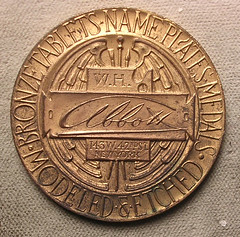
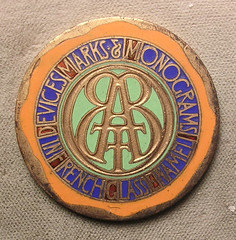
To read the earlier E-Sylum article, see: ON COLORING COINS AND MEDALS (www.coinbooks.org/esylum_v15n05a08.html)
THE BOOK BAZARRE
MORE ON THE ROCHESTER NUMISMATIC ASSOCIATION
Last week I asked:
Pete Smith writes:
I am not sure what qualifies a numismatist as being nationally known. Any of the following RNA past presidents might qualify: Dr. George French, George J. Bauer, Harry H. Yawger, George A. Gillette, William F. "Billy" Sunday, Paul M. Lang, Alphonse A. Kolb, John Jay Pittman, Charles J. Ricard, John Zabel, or Frank Van Zandt.
NBS members should remember that Frank Van Zandt served as our Secretary-Treasurer. We talked on the phone occasionally and I always treasured these calls. Frank was a student of native American and New York history. Apparently he was investigated about some of his native American artifacts. Dave Hirt, who served as Secretary-Treasurer after Van Zant was once contacted by agents of the Department of the Interior. They wanted to know what was in packages sent by Van Zandt to Hirt. These were not native American artifacts, but rather back issues of The Asylum.
In 2008, The Rochester Numismatic Association welcomed John Lighthouse as a new member. I am not aware of his accomplishments, but he shares his name with an earlier Rochester numismatist.
John C. Lighthouse died in 1909, less than three years before the formation of the RNA. In 2003, the ANA honored the Lighthouse / Ricard family for 100 years of membership and service to the ANA. Among these family members is TAMS board member and active NBS member, Marc Ricard.
I suspect the younger John Lighthouse may be related to the original John C. Lighthouse. Perhaps one of our NBS members can cast some light on this relationship.
Nick Graver writes:
Readers might wonder that member # 1 of the Rochester Numismatic Assn. is alive and well in the Chicago area! Charles Ricard did not attend our recent centennial dinner meeting, but sent a nice letter which was read to the group.
RNA membership cards are numbered each year, based on seniority, the lowest number being a member longer than any other person. Members get a lower number as others do not renew. Some might keep up their membership into old age, working down to being Member Number One. Sad, seeing old friends depart, on your way to number one-ship.
To read the earlier E-Sylum article, see: NEW BOOK: ROCHESTER NUMISMATIC ASSOCIATION CENTENNIAL HISTORY (www.coinbooks.org/esylum_v15n05a05.html)
MORE ON EDWIN F. BITTER'S INSCRIBED BROWNING
In our February 15, 2009 issue Nathan Markowitz wrote:
I have a copy of an original Browning book on early U.S. Quarter Dollars and a fellow numismatist suggested I post a request on The E-Sylum for help identifying an owners inscription in the book. The book is inscribed: "Edwin F. Bitter November 3, 1930" in neat pencil. It looks original with nice script and no erasure marks.
I have contacted ANS and ANA and find no evidence of this individual as a collector. This is clearly NOT the famous Adm Bitler as some have suggested. I also searched social security records some time ago with one individual matching first and last name (not middle initial) in Essex New Jersey who could represent the same person at about that time (he would have been age 39 at time of inscription). It seems a bit odd that someone who was not a collector would have a copy of this book during the depression. Any information would be of great interest.
This week web site visitor Mark J Bitter writes:
The Browning book inscribed by Edwin F Bitter belonged to my Grandfather. Edwin F Bitter, of Milburn, NJ, was my Father's Dad and was a very avid collector of everything from coins to American Marshall Arms. He had many books that, after his death, were sold to collectors and one of his books somehow found its way to you.
Edwin F Bitter was a collector of all kinds of artifacts. Stones, coins, animal skins and skulls, insects, books, and guns. His collection of flintlock pistols was perhaps the best in the world and the only person with a finer collection was my Father, Edwin W Bitter. Of course, the comparison is a bit unfair as my Grandfather gave him a very good head start! Among the more important and noteworthy guns were George Washington's personal side arm as well as many other of the finest examples of American origin. This collection of flintlocks was so fine that the Smithsonian sought to acquire it and did so in the 1990s, pledging to build a permanent gallery to display the collection.
Edwin F Bitter was a remarkable man and during his varied career he was in the alcohol business among others. So successful was he that after prohibition he and several of his associates, including Joe Kennedy, sought to acquire distillers in Europe that had been badly weakened by the reduced volumes shipped during prohibition. Later on, he acquired a significant amount of real estate in South Florida including, among many other holdings, what would later become the Galt Mile in Ft Lauderdale.
Please let your reader know that he owns a book that was signed and inscribed by a remarkable man!
To read the earlier E-Sylum article, see: QUERY: EDWIN F. BITTER'S INSCRIBED BROWNING (www.coinbooks.org/esylum_v12n07a11.html)
CLIFFORD HEWITT - CHIEF ENGRAVER OR CHIEF ENGINEER?

Coin World this week (in February 13th issue) has a great page one article on the surfacing of the Wilson die for the obverse of the Manila Mint Opening Medal of 1920. The long article by CW staffer Erik Martin relates how the die was brought home as a wartime souvenir from World War II and saved by the soldier's family, often used as a paperweight.
Unfortunately Martin repeats an error promulgated by previous writers by calling Clifford Hewitt the designer of the medal and a "chief engraver." He was neither "chief" nor "engraver." He had been assigned the task to build the necessary equipment to establish a mint in the Philippines, to be located in Manila, the first such branch mint outside of the U.S.
Hewitt had no experience to design a medal. He was a machinist. To his credit Bill Swoger in his recent work, National Commemorative Medals (published 2008), rejected the fact that Hewitt designed the medal, that it was entirely the work of Morgan. He stated Hewitt was a "mint technician" and began his construction work in 1915 at the San Francisco Mint. Following the construction of the necessary coining equipment at the San Francisco Mint he was assigned the task to install the equipment on sight in Manila and teach the local craftsmen how to use it.
It stands to reason such a person familiar with minting machinery was sent to Manila to set up a mint rather than an engraver. Later research revealed Hewitt was foreman of machinists at the Philadelphia Mint. Again, no documentation of being an engraver.
If Hewitt had any contact with George T. Morgan at Philadelphia perhaps it was in conversation as "show the president on one side and the Philippines as an infant and the U.S. as the Motherland on the other." Morgan interpreted this as Lady Liberty or Lady Justice (with scales).
The design is distinctly Morgan, in typical Morgan style. The Wilson portrait was modified from a Wilson portrait by Morgan appearing on the Assay medals of 1914, a fact omitted by Martin in his article.
I have been unable to track back who first called Hewitt a "chief engraver." It was not Hibler and Kappen, published in 1963, but may have been Aldo Basso in his Coins, Medals and Tokens of the Philippines published 1968. Swoger states It was repeated by Neil Shafer.
What has not been revealed is any vita on Hewitt. Can any E-Sylum reader uncover Hewitt's dates of birth and death for example?
Also I would like to know: When was commercial electric generation first available in Manila? Was it in time for that 1920 mint opening? Was all that machinery equipped with electric motors? Remember it was not until 1901 that the Third Mint at 16th and Spring Garden Streets was completely electrified (one of the first electric plants in America!). Prior to that all machinery was run by steam power (and that Corliss steam engine at the Second U.S. Mint) and belting. Was the 1920 Manila Mint run by belts or electricity?
To visit the Coin World web site, see: www.coinworld.com
NOTES FROM E-SYLUM READERS: FEBRUARY 5, 2012
More on 'The Numismatic Journal'
Dan Hamelberg writes:
Regarding "The Numismatic Journal" published by L. S. Drowne, North Adams, Mass., I have 6 issues as listed in Bourne from Vol 1, #1, August, 1877, to Vol 1, #6, January, 1878. Each issue states that the Journal is published monthly, and subscriptions per year are 35 cents, but I have never seen any issues beyond the Jan., 1878 issue.
There were many numismatic journals started in the late 1800's, and many stopped publications without much or any notice. "The Numismatic Journal" may have been one of those. I will, however, keep an eye out in the event that additional issues show up
To read the earlier E-Sylum article, see: QUERY: ISSUES OF 'THE NUMISMATIC JOURNAL' (www.coinbooks.org/esylum_v15n05a12.html)
Swimming Polar Bear
 I saw the image of this Canadian 20 dollar silver bullion piece on a Coin Update mailing. I like it! It's a nice, clean image showing the animal at ease in its habitat. I don't remember ever seeing a coin with a swimming mammal. Neat depiction of the waterline, another feature I haven't seen. A well-done original design. Who's the designer who signed it "ED"?
-Editor
I saw the image of this Canadian 20 dollar silver bullion piece on a Coin Update mailing. I like it! It's a nice, clean image showing the animal at ease in its habitat. I don't remember ever seeing a coin with a swimming mammal. Neat depiction of the waterline, another feature I haven't seen. A well-done original design. Who's the designer who signed it "ED"?
-Editor
Brothel Token Story Spreads
Bill Rosenblum of Littleton, CO writes:
It took a while for this "in depth" article to reach the foot of the Rockies. This was in the January 31st on-line edition of the Denver Post. I haven't had a chance to read the hard copy of the paper yet to see if it was also in there. Obviously the "story" is becoming more condensed and with less facts as the story gets passed down from one news outlet to the other. And I'm sure they've never heard of the E-Sylum or Ursula Kampmann.
To read the complete article, see: Museum: Rare coin may be Roman brothel token (www.denverpost.com/watercooler/ci_19825837)
To read the earlier E-Sylum article, see: SPINTRIAE ARE NO BROTHEL TOKENS (www.coinbooks.org/esylum_v15n05a09.html)
On Cattle, Cows and Bulls
With a subject line of "Don't be cowed by all those wannabe ranchers", Joe Levine offers this note from WikiPedia:
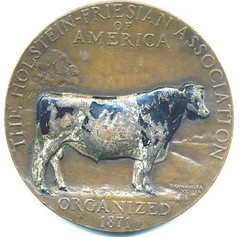 "Cow" is in general use as a singular for the collective "cattle", despite the objections by those who insist it to be a female-specific term. Although the phrase "that cow is a bull" is absurd from a lexicographic standpoint, the word "cow" is easy to use when a singular is needed and the sex is unknown or irrelevant - when "there is a cow in the road", for example.
"Cow" is in general use as a singular for the collective "cattle", despite the objections by those who insist it to be a female-specific term. Although the phrase "that cow is a bull" is absurd from a lexicographic standpoint, the word "cow" is easy to use when a singular is needed and the sex is unknown or irrelevant - when "there is a cow in the road", for example.
Further, any herd of fully mature cattle in or near a pasture is statistically likely to consist mostly of cows, so the term is probably accurate even in the restrictive sense. Other than the few bulls needed for breeding, the vast majority of male cattle are castrated as calves and slaughtered for meat before the age of three years. Thus, in a pastured herd, any calves or herd bulls usually are clearly distinguishable from the cows due to distinctively different sizes and clear anatomical differences. Merriam-Webster, a U.S. dictionary, recognizes the non-sex-specific use of "cow" as an alternate definition, whereas Collins, a UK dictionary, does not.
To read the earlier E-Sylum article, see: HOLY COW - THAT LOOKS LIKE A BULL! (www.coinbooks.org/esylum_v15n05a07.html)
Egypt Revolution Anniversary Coin Issued
P.K. Saha forwarded images of a new coin issued on the first anniversary of the revolution that overthrew Hosni Mubarak. Thanks!
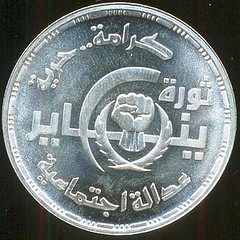
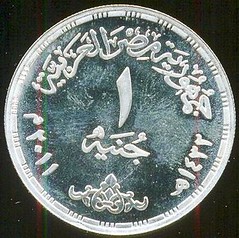
This is the first coin I'm aware of that commemorates any of the Arab Spring revolutions. On an unrelated topic, I have to note that the raised fist reminds me of the Huey Long "Washroom Warrior" medal
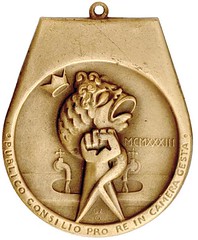
To read an earlier E-Sylum article, see: IRAQI SHOE-THROWING INCIDENT: SHADES OF THE WASHROOM WARRIOR (www.coinbooks.org/esylum_v11n51a18.html)
Denver Rapid Transit Eliminates Tokens
Bill Rosenblum writes:
There was a numismatic article in Thursday's Denver Post (Thursday) which I couldn't find online. The Denver Area RTD (Rapid Transit District) is discontinuing the use of tokens for buses and light rail. They stopped distributing the tokens as of January 2nd but will accept them in fare boxes and ticket vending machines through 2013.
The RTD district was created in 1969 and they have used tokens, as well as other means of payment, ever since. They plan to replace tokens with "smart cards". I moved to Colorado in 1971 but I believe that buses and trolleys were run by the Denver Tramway Company before RTD. At least I've seen their tokens in virtually every collection I've ever bought in Colorado. I'm sure another E-Sylum reader can correct me if I'm wrong.
My friend Chuck Mattson sent me the following history: "The Denver Tramway COMPANY started using tokens about 1917. That Company became the Denver Tramway CORPORATION and started tokens about 1942. Then the Regional Transportation District began using tokens in 1978"
Colonial Life Web Site
Ray Williams writes:
I thought this was a pretty cool website to get basic info about our colonial history. There's also a 6 minute video I enjoyed too. I thought E-Sylum readers might like it.
To bisit the web site, see: Colonial Life (apush-wiki-marlborough-school.wikispaces.com/Colonial+Life)
COLONIAL JACK'S LONG WALK
Regarding the 9,000-mile walk of John Albert Krohn, I quoted an Internet source saying:
"He set out from Portland on June 1, 1908, walked across the northern border to Seattle; went South to southern California; and then walked east across the deserts, Texas, and the deep South, before finally turning north around Pensacola, Florida. He returned home on July 21, 1908."
Mike Packard writes:
Long walk -- Did he really walk 9,000 miles in 52 days (about 175 miles per day) ? I suspect he either started in 1907 or finished in 1909.
I'd lifted the text from an eBay lot I was thinking of bidding on. I ended up bidding on and winning a new book for my library - a book written by Krohn himself, privately published in Newburyport, MA in 1910. It's a week-by-week account of his journey. He indeed started on June 1, 1908. The end date was a typo - it was July 19, 1909.

Here are some excerpts, one mentioning the numismatic connection, the tokens he produced.
From the Preface:
"Why did I push a wheelbarrow around the border of the United states? To make money selling my story."
"I wore out eleven pairs of shoes on the trip. They were purchased enroute, having had only two pair of the same make. I append the miles each pair of shoes carried me."
The longest-lasting pair took Krohn 1,728 miles; one pair only lasted 300. During his trip he visited 1,209 places, getting a post office stamp in a book he kept for the purpose of proving his story. This guy took notes on everything - "During the trip I wore out 121 pairs of stockings." He walked an average of 25 miles per day. His average expense per week was $22.80.
"In order to make both ends meet I sold souvenirs of myself, gave short talks of my trip in moving picture houses, advertising, etc.
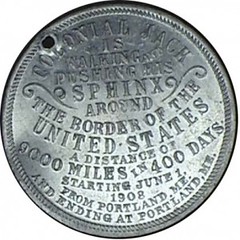 Regarding the sale of his souvenir tokens, he writes:
Regarding the sale of his souvenir tokens, he writes:
I heard many queer excuses for not buying a souvenir. Some of them are: "Haven't time to;" "I don't live in the town;" "I have got house full of souvenirs; "I am too old, let the young fellows buy them;" "I can't read;"
We numismatists can be grateful to those who did buy Krohn's tokens and set them aside for collectors of today. His trip diary is a wonderful account of his travels, the places he saw and the people he met. I think historians will find it a useful slide-of-life account from the early 20th century.
It was no walk in the park - Krohn had to deal with bad weather, illness, scorpions, policemen and railroad people. He had gotten written permission to be allowed to walk across railroad bridges. One time he slipped and got his ankle stuck. He lost several dollars in silver that fell from his pocket, and he feared for his life, but luckily he managed to extricate his swollen ankle before the next train came by.
What a great adventure - one that few people would ever be brave enough or foolish enough to try. A find like this is all part of the fun of numismatic research - you never quite know where it will lead you.
To read the complete eBay listing with several pictures, see: 1910 RARE 9000-MILE WALK of COLONIAL JACK Book AROUND UNITED STATES 1st PHOTOS (www.ebay.com/itm/330674422031)
QUERY: MINT DIRECTOR RAYMOND T. BAKER MEDAL INFO SOUGHT


I made a fortunate purchase on eBay recently, but I'm having trouble finding any information on it.
The medal I purchased was described by the seller as brass, but at $18 plus shipping it would have been a bargain in any metal. I was amazed that no one bid against me. It appeared from the photos to be tarnished silver, and my hunch turned out to be correct. When it arrived, I had the medal x-ray tested and found that its composition is 95% silver and 3% copper, with the balance being a blend of trace elements.
George Morgan's U. S. Mint's 3-inch medal honoring Mint Director Raymond T. Baker is listed in its old catalogs as Number 313 in bronze, but there's no mention of silver strikings. The bronze strikings have been unavailable from the Mint for about 30 years and are now somewhat scarce.
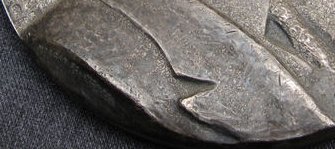 The piece I purchased weighs 7.85 troy ounces, significantly more than bronze medals of that size. The problem is that I can't find out anything about it regarding the number struck and its rarity. My specimen has raised text on the truncation of Baker's bust reading MORGAN SC. MCMXXI, and there are two round areas of disturbance on the upper edge indicating that it must have been suspended at some time.
The piece I purchased weighs 7.85 troy ounces, significantly more than bronze medals of that size. The problem is that I can't find out anything about it regarding the number struck and its rarity. My specimen has raised text on the truncation of Baker's bust reading MORGAN SC. MCMXXI, and there are two round areas of disturbance on the upper edge indicating that it must have been suspended at some time.
I'm hoping that readers will know something of this medal or can point me in the right direction.
A TALE OF TRAVELING COIN BUYERS

The couple walked into a small room at the Hilton Garden Inn this week, carrying one old coin that ended up being worth thousands of dollars.
Josh Cunningham of the Illinois-based International Coin Collectors Association, said on Tuesday, the second day of the association's six-day stay in Newport News this week, two couples brought in extremely rare coins.
The collectors association is buying old coins, to later make a profit by selling to private collectors. The association travels all over the United States searching for old coins.
The first rare coin was a 1652 Pine Tree Shilling, which was probably among the first coins to be minted in the colonies, in Massachusetts, according to the Legendary Coins and Currency web site.
"They had no clue that it was that valuable," Cunningham said of the couple that brought in the Pine Tree Shilling. "I had never seen one that was real. I had seen lots of fake ones."
The shilling is worth $6,000 or more, Cunningham said on Wednesday.
Meanwhile, another couple showed up at the Hilton Garden Inn with a 1785 "bar copper" that was minted in the newly-formed United States. The "bars" on the tails side of the coin represent the 13 states. That coin is worth about $1,000, Cunningham said.
Tom writes:
Definitely cast replicas. Shouldn't fool anybody, including a traveling road show buyer. Think it could be a shill story set up by the buyers for local publicity?
To read the complete article, see: Rare coins being bought, sold in Newport News (www.dailypress.com/news/newport-news/dp-nws-nn-old-coins-20120201,0,2046603.story)
THE BOOK BAZARRE
STILL TIME TO SUBMIT YOUR BIDS ON A WIDEVARIETY OF NUMISMATIC TREASURES
IN OUR AUCTION SALE
DAVID SKLOW - FINE NUMISMATIC BOOKS
www.finenumismaticbooks.com
Mail Bid Sale No. 15 Closes FEBRUARY 11, 2012
MORE BANKNOTE MATH: GREEK INFLATION NOTES
Martin Purdy writes:
The "math question" about the Turkish 100-lira notes was interesting - assuming the man who made the claims about Nelson's Column wasn't just picking numbers out of thin air, could he perhaps have been talking about laying the notes end to end rather than stacking them?
Removing my tongue from my cheek, I have another "banknote math question", which I asked on an on-line forum a couple of years ago and got precisely zero answers. Perhaps one of our readers may be able to assist. The questions relate to the high-denomination notes of Greece issued during WW2 and the way they are/were listed in the Standard Catalog of World Paper Money:
"While doing some research I noticed an inconsistency in the descriptions of Greece, P134 and P135, in SCWPM, Vol. 2, 10th ed., pp. 549-550:
"P134 (10 billion dr.) is listed as "10,000,000,000 drachmai" "P135 (100 billion dr.) is listed as "100,000,000,000,000 drachmai"
"No problems with the 10 or the 100, but the "billion" part is problematic. The notes use the same word in each case (disekatommyria), so both can't be correct. I do not claim to be an expert, but always assumed that Greece used the "German" billion (i.e. 10^12) rather than the "US" billion (10^9). Part of my reasoning was that P133 (2x 10^9 drachmai) bears the Greek denomination DUO KHILIADES EKATOMMYRIA (i.e. two thousand million), not *DUO DISEKATOMMYRIA (two billion).
"One or t'other needs correcting, in any case. Can anyone offer more conclusive evidence in either direction please?"
I realise my 10th edition is ageing somewhat by now, and this may well have been attended to, but I'd still like to sort out the math/language question even just for my own education.
To read the earlier E-Sylum article, see: BANKNOTE MATH QUESTIONED (www.coinbooks.org/esylum_v15n05a24.html)
CAL WILSON'S NUMISMATIC REPOSITORY
Last week Joe Foster inquired about Cal Wilson's last Repository issue, Vol 5 nos. 5 and 6, published electronically in October. 2001. Roger Siboni was the first to come forward with an offer to help, writing:
I think I have a complete run of Cal Wilson's Repositories, fixed price lists and a few other related items.
David Gladfelter also offered assistance. Stephen Pradier came forward with electronic copies of Repository issues, and I've forwarded the requested one to Joe. Below is a short excerpt from that issue. Elsewhere ins this an future E-Sylum issues I'll republish some items from them. Reading through some of these has been a real trip down biblio memory lane. Thanks!
This issue of THE REPOSITORY has been a long time coming -- thirteen years and six months to be exact. Perhaps a record has been set for the longest hiatus for an American numismatic literature periodical. In any event, the proof that the journal is still alive now rests firmly in front of you.
There was never an intent to halt publication, even following the closure of my bookstore in 1991. As most of my long-time readers are aware, the numismatic literature marketplace is not the most lucrative of enterprises. For ten wonderful years, though, I had the pleasure of indulging in a labor of love. During that time, I experienced the joy of handling some of the finest and rarest numismatic works ever produced. I made many, many new friends and established long-standing relationships with numerous customers and fellow hobbyists. However, simple economics finally compelled me to throw in the towel and re-enter the "real world" of earning a regular paycheck.
To read the earlier E-Sylum article, see: QUERY: CAL WILSON'S NUMISMATIC REPOSITORY (www.coinbooks.org/esylum_v15n05a13.html)
MORE THOUGHTS ON OLD-TIME COIN AUCTIONS
I really enjoyed Harvey Stack's and Alan Weinberg's recent reminisces of how auctions used to be and how they changed . There is no substitute for the excitement in the room when a an old and quality collection crosses the auction block. The Internet is a part of this lost excitement. Similarly to the difference at a live NFL playoff game V.S. watching it in your living room.
Today's distant collector can bid from the comfort of his office. There clearly is no substitute witnessing a 6 ft plus distinguished looking Harry Bass standing on his chair at the back of the room with his arms and bidding number fully extended up to intimidate all buyers, because they knew his arm never came down until he won the lot. Then there was Kamal Awash who would stand on his chair and scream at the other bidders to stop bidding , and if they were close enough he might hit them in the head with his catalog. And who could forget Buddy Ebsen falling asleep and snoring.
These exciting days at coin auctions in the US are all but gone. It is rare today to witness this excitement , another factor nearly as large as the Internet is the fact that coins today are normally professionally graded . There was an exception last weekend when Alex Cooper sold the coin and currency collection of Arthur E Young of Red Loin PA. deceased since 1956. All of Mr. Young's coins were housed in Wayte Raymond binders and pages nearly all with original color and surfaces all items were sold without reserve and not professionally graded. There was electricity the room among all the collectors and dealers who came in the attempt to add to their collection or inventory. Mr. Young's coins came from Homer Downing Hayes, Barney Bluestone and Stack's.
His 1794 half cent C4A is destined for an uncirculated holder. His 1794 S29 cent as choice and early cooper as I ever seen , all though not quit uncirculated . The gorgeously toned 1873 arrow 25 cent piece is possibly the finest known . The fact that these coins and paper money were certified allowed us to keep alive an illusion as to the possibly grade and value of a coin or note. The lack of this illusion has greatly diminished the excitement surrounding US coins and paper money for the collector.
To read the earlier E-Sylum article, see: HARVEY STACK: THOUGHTS OF AN OLDTIME AUCTIONEER (www.coinbooks.org/esylum_v15n05a18.html)
ELDER'S RECOLLECTIONS ON AN OLD COLLECTOR
by Thomas L. Elder
Scene. A New York Auction in 1902.
In that year, 1902, the writer was living in Pittsburgh. He had just established himself as a coin dealer, whole-time, although he had for long years been collecting and selling some coins. He used to make trips to New York, visiting Hoboken and other sections hunting up coins.
So he sauntered into Low's auction sales room in 1902. The room was located upstairs, in a small building on 4th Ave. and the auctioneer was one Henry C. Merry.
Here's the picture. The coins were mostly in envelopes, but a few of the gems were carefully boxed and exhibited inside a small case maybe 3 X 5 feet on the side. In sauntered the Chapman brothers, on their return from a coin hunting trip to Europe. They were hardly on speaking terms with Low, due to some disagreement, yet their curiosity led them to look over the room, the visitors and also the rarest pieces. Hudson Chapman walks quietly to the small case and asks to examine a Lord Baltimore six pence and an uncirculated 1796 U. S. Dime.
After careful comparison of notes by the two Chapmans they put the coins back and quietly walked out of the room. They looked but did not bid. Such was their feeling towards Low on that occasion. Presently appears in the room Mr. Low, a pompous looking man with a round face and a shiny bald head. He wore a mustache snow white and puffed at a long cigar. He had on a Prince Albert coat and a white vest. He was dressed to kill as the saying goes and looked fully the part of a prosperous and successful businessman. Well he might be as he was about the only coin cataloguer in the great city of New York. The older Frossard had died and the young Frossard was only beginning to hold a few scattered sales. Low had a sale about every two months.
Low was cheerful and confident. After the coins were put away the small crowd took chairs. I noticed men like H. T. Dawson, Isaac Cary of Brooklyn, Hillyer Ryder, maybe Carl Wurtzbach. Low was deliberate. His sales seldom ran over five hundred lots and sometimes barely four hundred. It was a long session always as he sold very slowly, indulging in a good many comments. He held his entire lot of bid sheets, usually not over 85, in one hand, and there were frequent pauses to look up a doubtful bid or to inquire into the standing of the bidder before he allowed Merry to knock down a lot. At time the progress became tedious, even exasperating to some people in the room who had to wait around for hours to get to a lot they were interested in.
Of course prices were far below today's. The uncirculated 1796 dime sold for $15.00, the Lord Baltimore six pence, really a gem brought only $20.00. Those were indeed low prices. 1877 cents, three and five cent coins were not bringing $2 each, in fact the 1877 proof cent went as low as $1.15 each -- yes the $45 coins of today. Minor proof sets of 1877 were usually sold as a lot.
So Low's sale moved slowly along. There was no rush and everyone had ample time to make up his mind whether to bid before any lot was knocked down. Yet Low sales were on the level and bona fide. He merely wanted to see justice done to the lots. The sales started at two o'clock and it was lucky if they ended at six p.m. Deliveries were slow and painful, in fact Mr. Low frequently invited bidders to go and get their lots the following day at his office which was then a building near 23rd Street on 4th Avenue. Dawson bid on ancient bronzes. Cary collected U. S. silver. Ryder collected early American. Ryder attended my very first sale in New York in 1905; so did Carl Wurtzbach. So did Dawson. Frossard had gone; left town for some unaccountable reason, never to return. What became of him I have never learned.
Low's sales continued for a long time on 4th Avenue, then Merry died and Dan Kennedy took his place. Low held sales at various places, finally at the Park Avenue Hotel. Then he moved to New Rochelle where he died about 1924.
MINNEAPOLIS PUBLIC SCHOOL CHALLENGE COINS
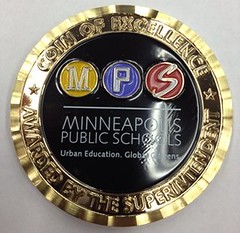 There's a new coin of the realm, er district, abroad in Minneapolis.
There's a new coin of the realm, er district, abroad in Minneapolis.
Superintendent Bernadeia Johnson has created a small token of appreciation that she's calling the "superintendent's coin." She's giving it both to distinguished guests and everyday employees who make extra efforts.
She dropped two coins on people in rapid succession earlier this month. Education Secretary Arne Duncan got his during a South High School appearance, the morning after Johnson gave another to Hashim Yonis at her Somali community forum and supper.
The supe has also presented coins to mentor Carol Johnson, now superintendent of Boston schools, and to school nurse Cynthia Hillyer, for increasing screening of preschoolers.
To read the complete article, see: Johnson coins a new award for extra effort (www.startribune.com/local/blogs/138323879.html)
JOHN PINCHES, LTD, MEDALISTS
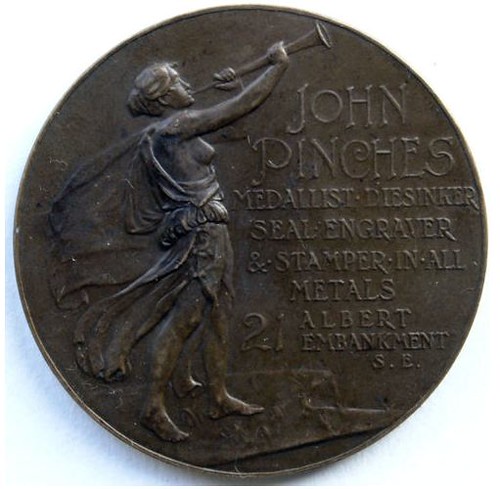
This is a beautiful art nouveau advertising medal which I have not seen before. It is not listed in the very thorough 271-page catalog of medals by the Pinches firm published by John Harvey Pinches in 1987. It must be quite rare and probably dates from circa 1900. It might be possible to determine a more exact date by researching the address given on the medal. If actually engraved by John Pinches, it would predate his death on 22 April 1905, but I see no signature on it.
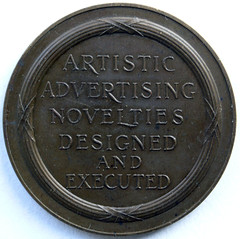 By the way, notice that the letters on the reverse are individually engraved (or individually modeled in plaster, then made into a galvano from which a die is traced with the Janvier). They are not made from punches. Also notice that the letter L was originally made in standard form, then embellished with a decorative base.
By the way, notice that the letters on the reverse are individually engraved (or individually modeled in plaster, then made into a galvano from which a die is traced with the Janvier). They are not made from punches. Also notice that the letter L was originally made in standard form, then embellished with a decorative base.
Surprisingly, there is very little information about John Pinches in Leonard Forrer's 8-volume Biographical Dictionary of Medallists. Pinches (1825-1905) was the founder of the firm of medalists known as John Pinches, Ltd. John studied under William Joseph Taylor from 1846 to 1851, then worked occasionally for Leonard C. Wyon, and also for the Birmingham Mint. It would seem from these facts that the Pinches firm would not have been established until 1851 at the earliest, but John Harvey Pinches's catalog covers "works struck by the company from 1840 to 1969". In 1969 the John Pinches firm was acquired by the Franklin Mint.
The firm originally consisted of John Pinches and his brothers Francis, Theophilus, Thomas and William. John's son John Harvey Pinches (1852-1941) was head of the firm in 1909 when the volume of BDM listing him was published. John Harvey Pinches was succeeded in turn by his elder son, John Robert Pinches (1884-1968) who maintained the firm's artistic direction almost until his death. The author of the catalog, another John Harvey Pinches, son of John Robert, thereafter conducted the business with his cousin Leslie Pinches, whose father Ernest Pinches looked after engineering aspects of the firm. Ernest was the grandson of Theophilus. Quite a family, I must say.
Author John Harvey Pinches writes: "With no prospect of a family succession, in 1969, an offer for the business from the Franklin Mint, Inc., of Philadelphia, U.S.A., was accepted. Their [i.e. Franklin Mint's] enormous success with issues of series of commemorative medals led to their expansion internationally. This success unfortunately led them to undervalue the old traditional business, which was dispersed."
J. H. Pinches goes on to say that when the Franklin Mint decided to discontinue the traditional business - the making of medals for companies, associations and societies as opposed to the production and marketing of medallic products to collectors - FM "disposed of the invoices and works records from about 1930." Other earlier records were lost in a Thames River flood before World War II. J. H. Pinches sought information from old clients whose addresses could be found, thereby restoring some of the lost information.
In the March 1970 issue of the Franklin Mint Almanac, the Pennsylvania firm's monthly publication, its acquisition of the Pinches firm along with the Wellings Mint of Toronto were described as major steps in FM's international expansion program by Harold Flynn, FM's VP for international marketing. Flynn was quotes as saying that these acquisitions would "extend the international recognition and acceptance of coins, medals and other works of art created by the Franklin Mint and its worldwide affiliates." Flynn described the Pinches firm as having "a 241-year-old tradition of outstanding medallic craftsmanship." Perhaps along the way, John Pinches, Ltd., itself had made acquisitions of firms going back that far.
This may be more than you wanted to know -
To read the earlier E-Sylum article, see: NOTES FROM E-SYLUM READERS: JANUARY 29, 2012 (www.coinbooks.org/esylum_v15n05a10.html)

TELEVISION APPEAL BRINGS NEW LEADS IN STEWARTBY THEFT
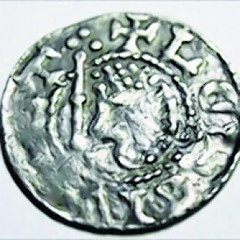 Police investigating the theft of £500,000 worth of coins have been inundated with tip-offs following a nationwide TV appeal.
Police investigating the theft of £500,000 worth of coins have been inundated with tip-offs following a nationwide TV appeal.
The rare coin collection, which was taken from the Broughton home of Lord and Lady Stewartby in June 2007, features coins dating back to 1136 and is considered by experts to be Scotland's best rare coin collection.
Detectives investigating the crime had hit a dead end despite a £50,000 reward for information.
However a BBC Crimewatch appeal last Thursday night has led to over 40 calls being received and Lothian and Borders Police said they will now analyse the information received before following up any new lines of inquiry.
Lady Deborah Stewartby hopes the renewed appeal will lead to the recovery of the coins, as the crooks realise they can never actually sell the items.
She said: "These coins are too well known now, they can never be sold. This collection of coins is a national treasure and they should be on display for all to see.
"What is really galling for us is that my husband was about to hand them over to the National Museum of Scotland before they were stolen and that is where they will go too if recovered.
"It is our hope that whoever has them realises that they will never sell and just hands them back. Hopefully one day this collection will be on display for the benefit of the nation in Edinburgh."
Nick Holmes, senior curator of numismatics at the National Museum of Scotland, said: "This collection is a unique part of Scottish history and the impact of its loss cannot be overstated."
Police have agreed that it would be almost impossible for a thief to sell the coins because they are so famous.
A spokesman said: "The coins are unsellable on the market because they are so well known, and dealers and others in the coin trade have been checking the source of any early Scottish coins that appear for sale.
Lord Stewartby, a former government minister, first started collecting coins at the age of ten and had amassed his special collection over a period of 50 years.
More than 1,000 coins were taken in the raid while the former Tory MP and his wife were on holiday in June 2007.
To read the complete article, see:
New leads in coin theft
(www.peeblesshirenews.com/news/roundup/articles/2012
/02/03/423233-new-leads-in-coin-theft/)
To read an earlier E-Sylum article, see: LORD STEWARTBY SCOTTISH COIN COLLECTION STOLEN (www.coinbooks.org/esylum_v10n28a17.html)
WHERE DID ANNIE OAKLEY'S BULLETS COME DOWN?
Web site visitor Rick Sage writes:
I read the article on a coin supposedly shot by Annie Oakley. At the end of your comments, you asked "Where did the bullets come down?" Did anyone ever supply an answer? I just watched the PBS special on Annie and had that exact question for all her expositions. Where did the bullets go? I do a lot of hand gun shooting and have used wax bullets before, they can penetrate soda cans at 40 feet, so even if Annie used wax bullets, someone would be in harms way just as with the use of lead bullets.
So - is there any answer to our question?
Also - I live in Cincinnati, close to a site mentioned in local folk lore as the place where Frank Butler challenged Annie to a match, got his clock cleaned and thus started their relationship. Since he lived in Oakley (a part of Cincinnati) that's where Annie got her stage name.
Rick Sage writes:
Here are photos of shot coins I found in the woods around the site of "Schuetzenbuckel" - German for Shooter's Hill. It's at the East end of Fairmont Ave in Cincinnati Ohio. Originally the site of a Baptist Seminary, Medical College and Military Academy.
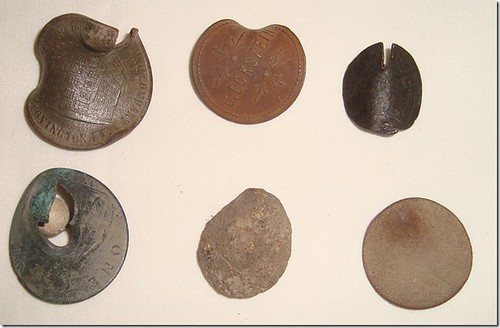
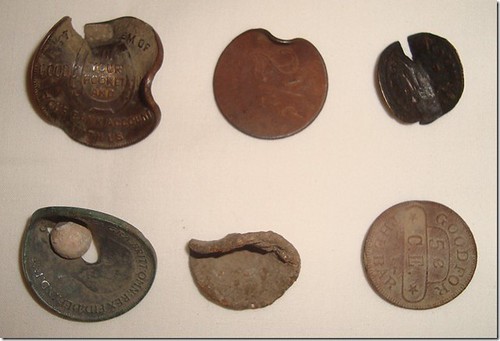
Local Oral Historians note this as the site where Frank and Annie had their competition. This was a skeet shooting competition and not a rifle match. So the shot coins I've found cannot be directly attributed to being shot by Frank or Annie. They are all Trade Tokens except for the one I found with the offending projectile still attached. It's a Great Brittan Penny, but I cannot read the date. They are all from the period of 1860-1890 (give or take) so they fit the time frame of the match between Frank & Annie.
Shooter's hill was closed down around 1888 after a fire destroyed the main building. Most of the building remains were pushed over the hill sides and the site is now a city park with soccer and baseball fields. Coins were found on the hill side/woods surrounding the area.
I've done a lot of metal detecting over the years and just recently disposed of the vast majority of my "Finds". Kept these as they were of special interest only to me. Have about 8 or so wheat pennies that have also been shot. These were found at various sites around town. More than likely shot in a standing position and not thrown in the air. Have a large glass battery case that is half full of just bullets that I've recovered over the years. About 30 pounds worth of lead.
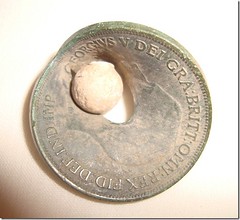 It's my understanding that Annie (and other sharp shooters) could shoot through the hole in a washer thrown in the air. It was "proven" by pasting a postage stamp over the washer and then tossed in the air with the shot going thru the hole and piercing the postage stamp. I've heard of some offered for sale before, but never seen one. The History Channel has a sharp shooter show on every now and then and have replicated some of these shots. I've tried to contact them as to our common question of "Where did the Bullets Go?". I never got a response. In an outdoor setting, all shots could be made in a direction towards a woods, embankment or open field. But there's always room for errors. But how did they do their shots indoors in tents, theaters and halls? lead backdrops? I just don't know.
It's my understanding that Annie (and other sharp shooters) could shoot through the hole in a washer thrown in the air. It was "proven" by pasting a postage stamp over the washer and then tossed in the air with the shot going thru the hole and piercing the postage stamp. I've heard of some offered for sale before, but never seen one. The History Channel has a sharp shooter show on every now and then and have replicated some of these shots. I've tried to contact them as to our common question of "Where did the Bullets Go?". I never got a response. In an outdoor setting, all shots could be made in a direction towards a woods, embankment or open field. But there's always room for errors. But how did they do their shots indoors in tents, theaters and halls? lead backdrops? I just don't know.
My wife and I currently are involved with Cowboy Mounted Shooting. We do competition hand gun shooting on horseback. We use 45 single action revolvers and shoot a course of ten balloons. We only get five shots per gun so we also have to change guns while running the course. We use BLANKS. A blank can break a balloon target up to 20 feet away (if you're lucky).
In all of your reenactments and gun fights in Tombstone and other Wild West acts, blanks are used (or just a casing and primer only, no powder). They are still dangerous at close range. I suppose that the Cowboys and Indians in Buffalo Bills Shows used blanks as they shot their way into the arenas. Otherwise there would be a lot of holes in those tents and a lot of dead spectators as well.
To read the earlier E-SYlum article, see: MORE ON THE ANNIE OAKLEY COIN (www.coinbooks.org/esylum_v13n27a16.html)
THE BANK OF ENGLAND'S GOLD STOCKPILE
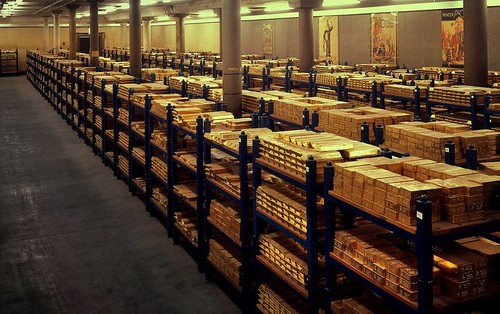
Cash-strapped British people will breathe a sigh of relief when they see these impressive treasure troves.
Despite the financial crisis, it seems the country still has some money left in the Bank of England's vault beneath London.
In fact, there are stacks of gold bars worth a whopping £156billion stored in an old canteen deep below the streets of the capital.
It seems Gordon Brown did not manage to completely strip the country of its assets when he sold off 400 tons of gold at rock-bottom price during his time as Chancellor. The gold he got rid of when prices were at a 20-year low cost the country up to £11bn, it was estimated last April.
On the walls of one of the vaults, posters from the 1940s are still visible, from when the vast room was used as a canteen.
The walls must be literally bombproof as they were used by bank staff as air raid shelters during World War II.
The old-fashioned posters that hang around the room depict sunny climes, luxury cruises and happier times - which may be as welcome a sight as the valuables for many. Three-foot long keys are needed to unlock to the doors that guard the rooms holding the gold - but sadly not all of it belongs to us.
Some is deposited by foreign governments as well as our own. Different shapes and marks distinguish the varying sources of the wealth.
To read the complete article, see:
We've still got a few quid then! Bank of England's glittering stash of £156BILLION in gold bars stored in former canteen under London
(www.dailymail.co.uk/news/article-2095535/Bank-Englands
-glittering-stash-156BN-gold-bars-stored-canteen-London.html)
CUTBACKS AT THE UTRECHT GELDMUSEUM
For years the new Geldmuseum in Utrecht struggles with serious budgetary problems. Now the bigger part of the staff will be laid off, services will be extremely reduced, the research department cut off, the library closed and much more. Here you will find an information send by the Head of Department and the Librarian.
Since the merger of the Royal Coin Cabinet, the Dutch Mint Museum and the numismatic collection of the Dutch Central Bank in 2004, the new Geldmuseum struggles with serious budgetary problems.
There was no other option than to reorganize the staff. Since the opening, it was obvious that the focus of the museum was no longer on numismatics, but on financial education. This already resulted in a permanent exhibition without collection, and in the end we can conclude that this change of direction made it easier to decide to cut off the research department. The director has chosen to keep the public side of the museum intact and sacrifice the scientific side, the Department of Collections and Research.
That has resulted in the lay-off of 9 people.
There are plans to keep the library open for a limited amount of hours a week, hosted by volunteers, but officially there is nothing said about it, yet. There will be no budget for new publications. The library collection will not be built up, exchange will diminish and the international network of numismatic libraries will not be co-ordinated anymore by the librarian of the Geldmuseum. Questions for information from the library collection by external users will hardly be answered and accessibility will be limited to almost none.
The library of the Money Museum houses a unique collection of scientific publications in the field of numismatics (coin and numismatics and paper), the financial culture and monetary history.
The collection consists of books, magazines, annual reports, reports, reprints, lists, archives and documentation. Besides the above collection of components there is a large collection of auction catalogs and much photographic material. The collection is largely made accessible via the catalog . The library collection is also accessible via Picarta, the Dutch Union Catalogue and Worldcat
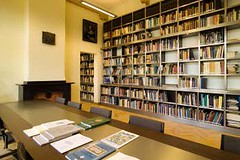 The library of the Money Museum houses a unique collection of scientific publications in the field of numismatics (coin and numismatics and paper), the financial culture and monetary history.
The library of the Money Museum houses a unique collection of scientific publications in the field of numismatics (coin and numismatics and paper), the financial culture and monetary history.
The collection consists of books, magazines, annual reports, reports, reprints, lists, archives and documentation. Besides the above collection of components there is a large collection of auction catalogs and much photographic material. The collection is largely made accessible via the catalog . The library collection is also accessible via Picarta, the Dutch Union Catalogue and Worldcat
To read the complete article, see: Cutbacks at Geldmuseum Utrecht (www.coinsweekly.com/en/News/4?&id=1005)
THE MILHOUS COLLECTION OF BOCA RATON
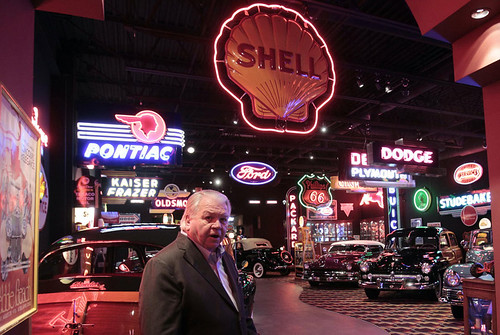
Say goodbye to the twirling carousel, the rows of perfectly shined classic cars, the player pianos and jukeboxes. They're selling all the neon signs, the slot machines, the antique guns, the Tiffany lamps, the hulking chandeliers. There will be no more rare organs or vintage gas pumps or the Army airplane gliding overhead, none of this out-of-this-world collection that took a lifetime to amass.
It will all be gone soon, before most people ever knew it existed.
Two brothers, Bob and Paul Milhous, are liquidating their one-of-a-kind private museum after spending decades scouring the world to find its gems. The Milhous Collection, as the items in their 39,000-square-foot building have become known, head to the auction block next month, estimated to fetch around $40 million.
"Our time's kind of up with them," said Bob Milhous, who at 75, is the elder brother. "It's time to move on."
The men first started picking up collectible cars and rare automated musical instruments a half-century ago, but they never knew it would grow into this. Their hobby became something of an obsession, with them buying so furiously their collections outgrew their own homes, then spilled into a succession of three increasingly larger spaces, until they built a new museum here, within a suburban corporate park, in a nondescript building that gives no hint of its holdings.
"Our wives say, 'Most people go to the museum and buy a postcard,'" recalled Paul Milhous, 73, "'You go to the museum and buy the museum.'"
What they have built is part carnival, part sparkling car showroom. It has both Vegas glitz and the refrained elegance of a Prohibition-era speakeasy. You find yourself in a room of thick red drapes, a massive crystal chandelier and a variety of musical instruments that line the walls then, moments later, in the glow of neon, surrounded by the chrome and steel of collector cars.
Quite simply, you've never seen anything like it.
"People come here and they leave amazed and then they try to explain it to somebody what they saw and it just doesn't work," Paul Milhous said.
The Indianapolis-born brothers are distant cousins of President Richard Milhous Nixon. They made their fortune in the printing business, making circulars and comic strip inserts for newspapers. They sold off that business in the 1990s, but were involved in a string of other manufacturing pursuits, making plastics, metals, ink, foam and on and on. They still have involvement in a number of real estate ventures, but have liquidated other businesses in their holdings as they plan their estates. Giving up all their prized collectibles is part of it.
"'Don't leave this burden to us," Paul Milhous recalled his and his brother's wives saying.
And, so, on Feb. 24 and 25, it will all be sold. Two auction houses, RM Auctions and Sotheby's, have divided it up into more than 550 lots, each to be sold to the highest bidder.
There is the whimsical: Dozens of vintage toy cars, giant toy soldiers that once stood at FAO Schwarz in New York, funhouse mirrors and carnival sideshow banners. There is artwork, fine furniture and the contents of a turn-of-the-20th century barbershop.
But the real highlights are in the Milhous collections of classic cars, the mechanical musical instruments and the carousel that is the centerpiece of their museum.
There are 29 cars, 5 motorcycles, 2 tractors, a motorbike, a popcorn and peanut wagon and a PT-22 airplane. Among the cars is the only known surviving 1912 Oldsmobile Limited, which is estimated to bring bids around $1.5 million.
The instruments include music boxes, player pianos, band organs and orchestrions, which are made to simulate the sound of an orchestra all in one piece. There are dozens of theater, fair and dance organs. At least eight of the instruments have price estimates that exceed $1 million each. Many are elaborately decorated with oil paintings, stained glass, gold leaf and moving figurines.
The museum has been kept so private over the years the idea of opening it to the public for an auction makes the brothers a bit uneasy. It has played host to many charity events, but whenever they've opened it up, it has been to limited audiences, with off-duty police officers hired to stand guard over their prized possessions. Now, anyone who buys a $120 auction catalog will be able to come to the preview.
For now, they're preparing to bid farewell to it all, and enjoying their final moments with it. On a recent tour, they recalled their first purchases and remembered all the places they've driven their many cars. And as they walk into a dimly-lit second-floor room of the museum, its walls lined with all types of instruments, only one question comes from Paul Milhous' lips.
"What do we want to play?" he asks.
To read the complete article, see: Eclectic Florida museum to be emptied by auction (www.artdaily.org/index.asp?int_sec=2&int_new=53332)
THE HIGHLAND MINT'S SUPER BOWL COIN TOSS COIN
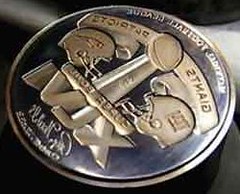 As it has for the past 21 years, a Melbourne company's product will have the attention of an estimated 170 million people on Sunday.
As it has for the past 21 years, a Melbourne company's product will have the attention of an estimated 170 million people on Sunday.
The Highland Mint, 4100 North Riverside Dr. , made the 1.5-inch diameter coin that will be used in the opening toss deciding whether the New York Giants or the New England Patriots kicks off or receives. After the game, the coin goes to the Pro Football Hall of Fame as part of its Super Bowl XLVI display.
The remaining 99 coins of the first 100 coins pressed are given to players and NFL dignitaries. The rest - about 9,900 - then are sold to the general public for $99.95.
Who is are Highland Mint officials cheering for? The Giants-and the Patriots.
"We can't go wrong either way," said Vince Bohbot, executive vice president. "Both teams have a strong fan base."
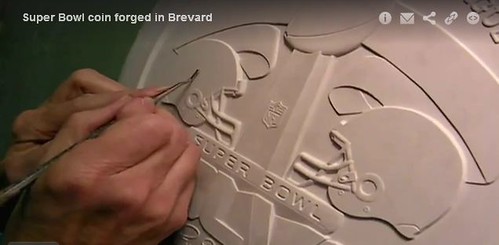
To read the complete article, see:
Melbourne's Highland Mint crafts official Super Bowl coin
(www.floridatoday.com/article/20120202/BUSINESS/120202022
/Melbourne-s-Highland-Mint-crafts-official-Super-Bowl-coin)
FEATURED WEB PAGE: THE HUNTERIAN COIN AND MEDAL COLLECTION
This week's Featured Web Page is the home of the coin and medal collection of the Hunterian museum in Glasgow, Scotland. Thanks to Coins Weekly for mentioning the Hunterian museum this week.The Hunterian houses one of the world's great coin collections, containing 70,000 coins, medals, tokens and related objects
About half is the original collection of Dr William Hunter put together at the end of the 18th century, when it was second only in importance to the French Royal Collection. Today it is Scotland's premier collection in this subject.
The collection contains Ancient Greek, Roman, Medieval and Modern coins as well as medals from the Renaissance to contemporary Scotland. Many of these are unique or extremely rare and most are in superb condition.
The collection is extensively used for teaching and research, and several catalogues covering its major holdings have been published

www.gla.ac.uk/hunterian/collections/
collectionsummary/coinsandmedals/
